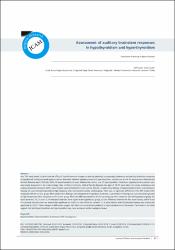| dc.contributor.author | Karalı, Elif | |
| dc.contributor.author | Güçlü, Ender | |
| dc.date.accessioned | 10.07.201910:49:13 | |
| dc.date.accessioned | 2019-07-10T19:50:19Z | |
| dc.date.available | 10.07.201910:49:13 | |
| dc.date.available | 2019-07-10T19:50:19Z | |
| dc.date.issued | 2018 | en_US |
| dc.identifier.citation | Karalı, E. ve Güçlü, E. (2018). Assessment of auditory brainstem responses in hypothyroidism and hyperthyroidism. Journal of Clinical and Analytical Medicine, 9(5), 411-415. https://dx.doi.org/10.4328/JCAM.5780 | en_US |
| dc.identifier.issn | 1309-0720 | |
| dc.identifier.issn | 1309-2014 | |
| dc.identifier.uri | https://dx.doi.org/10.4328/JCAM.5780 | |
| dc.identifier.uri | https://hdl.handle.net/20.500.12511/1947 | |
| dc.description | WOS: 000435652100011 | en_US |
| dc.description.abstract | Aim: This study aimed to determine the effect of thyroid hormone changes on hearing pathways by assessing audiometry and auditory brainstem responses of hypothyroid and hyperthyroid patients and to determine whether hypothyroidism and hyperthyroidism patients are at risk for hearing loss. Material and Method: Between June 2008-July 2009, 25 hyperthyroidism (Graves, Multinodular Goitre) and 25 hypothyroidism (Hashimato hypothyroidism) patients who were newly diagnosed in the endocrinology clinic of Duzce University Medical Faculty between the ages of 20-50 were taken into study. Audiometry and Auditory brainstem response (ABR) measurements were performed for each patient. Results: In audiometry findings of hyperthyroid patients, a sensorineural hearing loss was detected especially at high frequency when compared to normal control group. There was no significant difference in the ABR results when compared with the control group. When audiometric findings were interpreted in hypothyroid patients, a sensorineural hearing loss was detected especially at high frequencies when compared to the control group. When the ABR measurements of the control group were compared with the hypothyroid group, the wave latencies I., III., V. and I-III, I-V interpeak latencies were higher in the hypothyroid group, but the difference between the first wave latency and III-V and I-V interpeak latencies was not statistically significant (p>0,05), but the difference between III., V. wave lattices and I-III interpeak latency was statistically significant (p < 0.05). These changes in ABR waves suggest that there are retrocochlear problems in hypothyroid patients. Discussion: The results of our study suggest that both hyperthyroidism and hypothyroidism may have an impact on the hearing pathways. | en_US |
| dc.language.iso | eng | en_US |
| dc.publisher | Derman Medical Publishing | en_US |
| dc.rights | info:eu-repo/semantics/openAccess | en_US |
| dc.subject | Hyperthyroidism | en_US |
| dc.subject | Hypothyroidism | en_US |
| dc.subject | Audiometry | en_US |
| dc.subject | ABR | en_US |
| dc.subject | Hearing Loss | en_US |
| dc.title | Assessment of auditory brainstem responses in hypothyroidism and hyperthyroidism | en_US |
| dc.type | article | en_US |
| dc.relation.ispartof | Journal of Clinical and Analytical Medicine | en_US |
| dc.department | İstanbul Medipol Üniversitesi, Tıp Fakültesi, Cerrahi Tıp Bilimleri Bölümü, Kulak Burun Boğaz Hastalıkları Ana Bilim Dalı | en_US |
| dc.identifier.volume | 9 | en_US |
| dc.identifier.issue | 5 | en_US |
| dc.identifier.startpage | 411 | en_US |
| dc.identifier.endpage | 415 | en_US |
| dc.relation.publicationcategory | Makale - Uluslararası Hakemli Dergi - Kurum Öğretim Elemanı | en_US |
| dc.identifier.doi | 10.4328/JCAM.5780 | en_US |


















